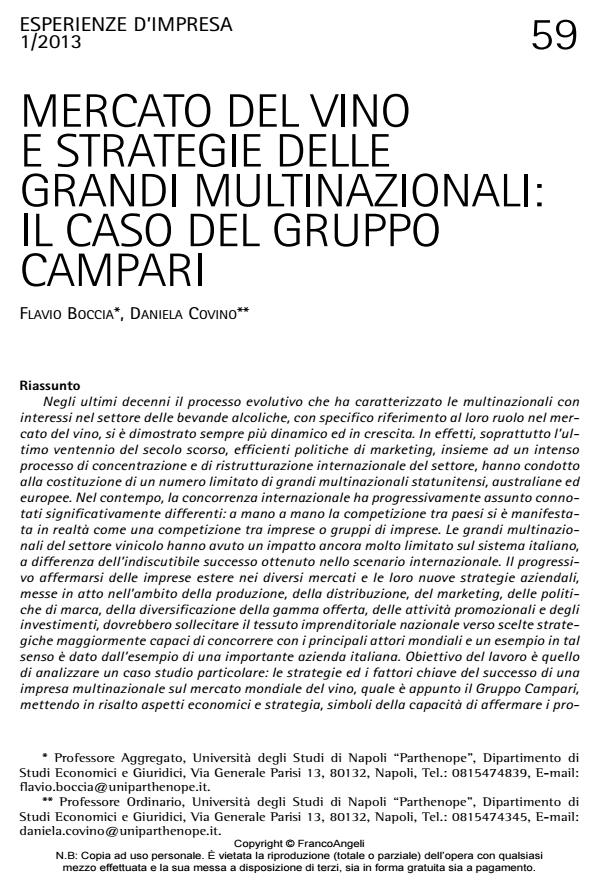Wine market and big companies’ strategies: the campari group case
Journal title ESPERIENZE D'IMPRESA
Author/s Flavio Boccia
Publishing Year 2013 Issue 2013/1 Language Italian
Pages 20 P. 59-78 File size 295 KB
DOI 10.3280/EI2013-001003
DOI is like a bar code for intellectual property: to have more infomation
click here
Below, you can see the article first page
If you want to buy this article in PDF format, you can do it, following the instructions to buy download credits

FrancoAngeli is member of Publishers International Linking Association, Inc (PILA), a not-for-profit association which run the CrossRef service enabling links to and from online scholarly content.
The evolutionary process that has characterized the multinational alcoholic beverage companies, with specific reference to their role in the wine market, proves to be always-growing and more dynamic. That is also thanks to efficient marketing policies, and to an intense international concentration and reorganization process of the alcoholic beverages sector which has brought to the establishment of a limited number of huge American, Australian and European multinational companies. At the same time, international competitive has deeply changed: today, we can no more talk about competition between countries, but we have to refer to competition between companies or groups of companies (often results of combination and take-over processes, also by actors completely unrelated to the market, as financial companies, insurance groups, merchant banks). The Old world of wine and the New one are not strictly opposed: the real difference is between companies which have focused on winning market-oriented strategies and those which have remained product-oriented. The effects of the strategies of the main multinational beverage companies in the Italian wine sector are still very limited, differently from the undoubted world success obtained: by the right changes, Italy (already at the top of international wine market) could conform itself to the new requirements of entrepreneurial competition and have a special attention to the way companies relate with the market. The progressive growth of foreign multinational companies in different markets and their new company strategies, regarding production, distribution, marketing, brand policies, product diversification, promotional activities, investments and social responsibility, should push the universe of Italian small and medium enterprise to follow action lines that are capable to let them compete with the main global actors, with good chances to succeed, according to the model guide of Campari Group. The goal of the present work is to analyse a case study: the strategies and the key factors of the success of one multinational company on the world wine market (the Italian Campari Group) and to show economic aspects and successful strategy, as well as the ability to assert its products in more competitive markets, such as those ones of the New world wine countries. .
Keywords: Company, enterprise, market, strategy, trade, wine
- Bernetti I., Casini L., Marinelli N. (2006). Wine and globalization: changes in the international market structure and the position of Italy. British Food Journal, 4, DOI: 10.1108/00070700610657146
- Boccia F., Sarno V. (2013). Consumer perception and Corporate social responsibility: perspectives for the Italian market. Journal of Calitatea – Quality: Access to Success, 14, 132.
- Boccia F. (2009). Internazionalizzazione, multinazionali e settore agroalimentare. Roma: Aracne editrice.
- Cesaretti G.P., Regazzi D. (2007). Leve strategiche per lo sviluppo dei sistemi territoriali a vocazione agro-alimentare. Milano: FrancoAngeli.
- Covino D., Boccia F., Di Donato S., Regazzi D. (2008). Food quality and safety in agrofood system: Economic and technological innovations. Italian Journal of Agronomy, 3, 1 Suppl.: 173-190.
- F.M.I. (2012). F.M.I. wine study: the economic impact of allowing shoppers to purchase wine in food stores. Food Marketing Institute.
- Hall C.M., Mitchell R. (2008). Wine marketing a practical guide. Elsevier, BH ed.
- ISMEA (2005). Panel aziende agricole: la viticoltura da vino italiana e l’OCM. www.ismea.it, Roma.
- Julia F., Coelho A.M., Couderc J-P. (2006). Analyse Mondiale (Historique Récent, Stratégies et Prospectives) des Fusions, Acquisitions, et Investissements Dinanciers des Principaux Acteurs du Secteur. Etude commissionnée par les organisateurs de la London International Wine & Spirits Fair, Vertumne International et Associés, Bordeaux.
- Mariani A., Boccia F., Pomarici E. (2007). Vite e vino nel mercato. La vite e il vino della collana Coltura&Cultura, Edizioni Bayer CropScience.
- Mediobanca (2006). Indagine sul settore vinicolo. A cura dell’Ufficio Studi di Mediobanca, Milano.
- Moulton K.S., Lapsley J.T. (2011). Successful Wine Marketing. Ed. Springer.
- Pomarici E., Boccia F., Catapano D. (2012). The wine distribution systems over the world: an explorative survey. New Medit – A Mediterranen Journal of Economics, Agriculture and Environment, 4, Ciheam-Iamb.
- Pomarici E., Boccia F. (2006). La filiera del vino in Italia: struttura e competitività. In: Cesaretti G.P., Green R., Mariani A., Pomarici E., a cura di, Il mercato del vino: tendenze strutturali e strategie dei concorrenti. Milano: FrancoAngeli.
- Porter M.E. (1986). Competition in global industries. Boston: Harvad business school press.
- Rabobank (2009). The International Wine Business. Rabobank International – Food & Agribusiness Research, Utrecht.
- S.R.M. (2005). Il Sistema agroalimentare nel Mezzogiorno. Associazione Studi e Ricerche per il Mezzogiorno. Napoli: Alfredo Guida Editore.
- New Money in Rural Areas Nick Gallent, Iqbal Hamiduddin, Meri Juntti, Nicola Livingstone, Phoebe Stirling, pp.33 (ISBN:978-981-13-0769-0)
Flavio Boccia, Mercato del vino e strategie delle grandi Multinazionali: il caso del Gruppo Campari in "ESPERIENZE D'IMPRESA" 1/2013, pp 59-78, DOI: 10.3280/EI2013-001003